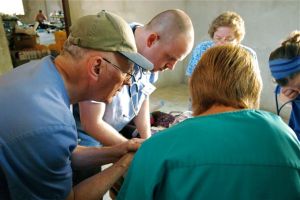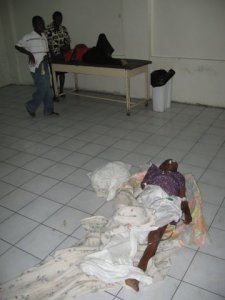“Dr. SW101,” said Father Larry, “There’s a woman lying unconscious in the church courtyard. Can you go see her?”
With little more than a quick nod, I grabbed my interpreter and headed out the door. How, I wondered as harsh sunlight spilled into my eyes, is a doctor supposed to help an unconscious patient? In Haiti.
I tried to think of all the reasons a woman might collapse, and what sort of assistance I might be able to offer. Again…in Haiti.
Quickly, I reviewed ACLS in my head. I tried to revise the arcane algorithms based on the fact that we probably did not have ONE SINGLE med used in a typical code. I thought through hypoglycemic coma, and stroke signs and symptoms. I tried to recall how I might distinguish between ischemic and hemorrhagic types (and would it help to know the difference?).

Also on my list of worries were seizures, pulmonary emboli, electrolyte disorders, dehydration and the difference between heat exhaustion and heat stroke. Distantly, I pondered the probability of this being a simple “waiting delirium” where people fake a collapse to get to the front of a line.
I approach what must be the patient but of course I can’t see her. All I see is a giant throng of people hovering in a circle; a shark frenzy of curiosity.
My interpreter helps me push through the crowd to a thin elderly woman lying with eyes half closed on a tattered blanket. She was placed in the half-shade of a skinny, leafless tree on dusty cobblestones just outside the church offices. People are yelling and pointing in all directions. They give me space grudgingly.
I learn that the woman had a seizure sometime in the night, passed out, and has been seizing regularly ever since. She is completely unresponsive. Someone tells me she’s around 70 years old. Someone mentions that she’s a grandma. Someone says it’s hot out.
After a brief exam, I have her brought into our clinic and placed her on a army-issue stretcher. I rummage around our supplies with the help of a spectacular nursing student named Kim. Together we come up with an angiocath (for IV’s), a bag of normal saline…even some gauze.
We place the IV and get some fluids running to treat possible dehydration. Kim and an OB nurse place a foley urine catheter we happen to have too. Clear urine runs into the bag, ruling out dehydration. We find urine test kits and note that there is no blood or glucose in the urine, thus arguing against diabetic problems or UTI.
The immediate problem was the seizures. And we had no medicines we could give a patient who, every 15 minutes or so, had a full seizure on the entire left side of her body. Kim and I riffled through the meds again and found some dilantin (good for seizures)…but in pill form, which made them totally useless.
Knowing the patient would die in her current state, I wrestled with the problem of how to get some sort of sedative – ANY sedative – into her tortured body. At one point a group of us seriously considered IV Haitian Rum. I thought about crushing up the dilantin and trying to trip a slurry down her throat, or pushing it rectally.
We eventually found liquid dilantin; made for oral administration. The discovery felt like a ray of sunshine in a mausoleum. Now all we needed was a naso-gastric (NG) tube. Gotta be lots of those lying around, right?
None. The patient is seizing again, Dr. SW101. The family is getting frantic. People are looking in at the patient through every window. What do we do?
Kim and I did find a feeding bag. Looking at it, I envisioned how we could fashion some version of an NG tube out of the tubing from the bag. I talked up my plan to Kim. Seeming like this kind of thing was a daily occurrence for her, she retrofitted the tubing, reversed the adapter connections…lubed the thing up and slid it right down into the patient’s stomach. Perfect. I had my tube.
I dose out my best guess for the patient’s weight, not knowing her renal function, her hepatic status, her chronic diseases or her current metabolic state. I gave it my best guess – shooting for safety and efficacy – and we started a regimen of dilantin.
Along with trying to treat this patient urgently, we knew this woman needed to be in a hospital, and Father Larry had been working on the weirdly complicated logistics of transporting a critical patient to General Hospital in Port Au Prince. Father Larry also supported my desire to stay with my patient to make sure that someone on the receiving end knew the story and could adaquately take over for us.

Not ungently, we put the woman in the back of a tough Isuzu jeep and then blasted out of Thomaseau over rocks and roots and dusty country roads, headed for the thriving city of Port Au Prince. Nearly 2 hours later, sweaty and dusty, we pulled in through the hospital gates.
My driver and translator is something of a celebrity in the village and knows many people in Port Au Prince also. He did some quick talking at a back entrance to the ER, and ran back to our car and told me to, “help me pick her up…quick! They’re letting us in the back. Otherwise we have to go through the front and it will be at least 8 hours until she is seen.”
We carry the woman through wards teeming with people. I sense many stares as I pass as quickly as possible through hordes of sick patients, family members, hospital staff and equipment. We enter an austere room made of tile and bricks, with windows high above us grudgingly tossing some light to the floor. A kid of about 15 is walking back and forth, tears streaming down his face as he intermittantly screams and jams his hands down his pants (psych? testicular tortion maybe?).
“Lay her here.” Instructs Bobby, my interpreter, the celebrity-guy.
“Right here? On the tile?” I reply, looking around anxiously. “Where’s the bed?”
“No beds. There won’t be one for hours. Maybe days. It’s leave her here or we take her back.”
We lay her on the floor. Two of her family members that came with us huddle on the cold linoleum next to her. I tell her story to a bored and tired looking orderly.
“Ok. They’ve got it from here.” Says Bobby, already heading for the exit. “Stay any longer and they’re going to demand more money to keep her. We need to get out now while we can.”
Fighting a sense of revulsion at the place where I’m leaving my patient, and vicerally wrestling with nearly-overwhelming waves of guilt for abandoning her, I snap a quick photo and leave.
As we walked away, I knew she would die on that cold, lonely floor. Her family trusted her to me, and I left her lying in a tile grave.

Not long after we returned to Thomaseau, after a harrowing drive through some of the worst slums in Port Au Prince – and in the entire Western Hemisphere – after hours and hours of efforts to save a life…she died. Probably from a stroke that occurred before we found her in the courtyard. Within 2 hours of our return to the village we were notified that the patient was gone. Please come collect the body. We wouldn’t have given her a bed in the hospital anyway because you didn’t pay for food and supplies.
We did calm down the seizures, by the way. By the second dose of dilantin, the repeated convulsions faded away and our patient clearly became more peaceful.
A small consolation.
The news of this woman’s death was somehow devastating to me, even though I knew she had no chance. I couldn’t help but get emotionally involved in something that required so much effort and focus.
And for all that work, I ended up with a dead patient; her last moments spent in squalor, destitution and abandon.
I have now spent hours trying to frame this experience in some sort of meaningful context; actively resisting raw emotions of fury and hopelessness and sheer nhilism. So far, I know only this: all I can really do for Haiti, is care about the suffering there.
And never, ever forget…
